
 |
|||
Recommendations to Protect Outdoor Workers
|
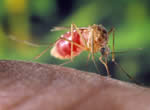 |
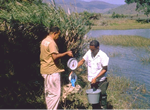 |
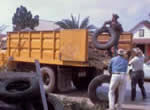 |
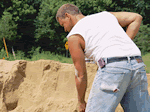 |
The West Nile virus (WNV) is spread to humans from the bite of an infected mosquito. The virus normally passes between mosquitoes and birds. However, people may also be infected if they are bitten by a WNV-infected mosquito.
The most likely route of WNV infection is through the bite of an infected mosquito. In addition, WNV may be spread through organ transplantation, blood transfusion, or possibly breast milk. Transplacental (mother-to-fetus) infection has occurred. Workers are at risk of WNV infection if their skin is penetrated or cut while handling WNV-infected tissues. Turkey breeder and alligator farm workers have been infected with WNV. The mode of transmission to these farm workers is uncertain.
Most human infections cause either mild flu-like symptoms or no symptoms at all. Mild symptoms may include fever, fatigue, headache, and muscle or joint pain. Although rare, some people may become severely ill. Severe symptoms may include high fever, stiff neck, disorientation, tremors, muscle weakness, and paralysis. Severely affected persons may develop encephalitis, meningitis, or meningoencephalitis—inflammation of the brain, membranes of the brain or spinal cord, or both, respectively. Severe cases of WNV may be fatal. Persons over the age of 50 are at higher risk of severe illness.
|
Occupational groups at risk should receive training that describes and reinforces the potential occupational hazards and risks of WNV exposure and infection. The importance of timely reporting of all injuries and illnesses of suspected occupational origin should be emphasized. A medical surveillance system should be in place which includes the reporting of symptoms consistent with WNV infection and employee absenteeism.
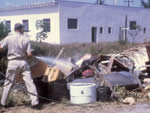 |
 |
 |
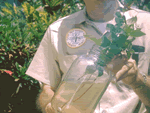 |
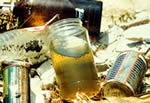 |
Where Are Mosquitoes Most Commonly
Found?
Mosquitoes develop in any standing body of water that persists
for more than four days. Stagnant pools, ponds, watering troughs,
irrigation ditches, rain barrels, manure lagoons, and other stagnant
bodies of water increase mosquito populations. Weedy, bushy, and
wooded work environments may also have large mosquito populations.
Workers in these environments should protect themselves from mosquito
bites. |
When Are Mosquitoes Most Active?
Many mosquitoes are most active from dusk to dawn. However, some
mosquitoes are also active during the day. When possible, avoid
working outdoors during mosquitoes’ peak activity times.
When this is unavoidable, use personal protection such as protective
clothing and insect repellent to reduce the potential for exposure.
|
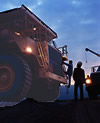 |
Recommendations for EmployersEmployers should protect their workers by implementing the following controls:
|
Recommendations for WorkersOutdoor workers can reduce their risk of WNV exposure by taking the following action steps:
|
| |
What Should I Do If I Have To
Handle Dead Animals?
Anyone handling dead animals should wear gloves. Appropriate gloves
provide a protective barrier that prevents blood and other body
fluids from passing through them. Medical examination gloves are
recommended. Cotton, leather, and other absorbent glove materials
are not protective. If latex gloves are used they should be reduced
protein, powder-free gloves to reduce workers' exposure to allergy-causing
proteins. |
What Should I Do If I Develop Symptoms Of WNV?
Any worker who develops mild symptoms of WNV such as fever, fatigue,
headache, and muscle or joint pain or severe symptoms such as
high fever, stiff neck, disorientation, tremors, muscle weakness,
and paralysis should contact their health care provider immediately.
The period from the infected bite to developing symptoms is reported
to be 3 to 14 days. |
 |
For updated information on WNV:
CDC West Nile Virus Home Page:
http://www.cdc.gov/ncidod/dvbid/westnile/
For more information about insect repellents:
CDC: Updated Information Regarding Insect Repellents
http://www.cdc.gov/ncidod/dvbid/westnile/RepellentUpdates.htm
CDC: Insect Repellent Use and Safety
http://www.cdc.gov/ncidod/dvbid/westnile/qa/insect_repellent.htm
U.S. EPA: How to Use Insect Repellents Safely
http://www.epa.gov/pesticides/factsheets/insectrp.htm
The National Pesticide Information Center (NPIC) can be contacted
by telephone at
1–800–858–PEST (1–800–858–7378),
9:30 a.m. to 7:30 p.m. eastern standard time, 7 days/week, or link
to the NPIC Web site:
http://npic.orst.edu
Reviewed June 29, 2005
Safer - Healthier - People |
For additional information, contact NIOSH: 1-800-35-NIOSH (1-800-356-4674) Fax: 513-533-8573 or visit the NIOSH Web site: www.cdc.gov/niosh |
|
|